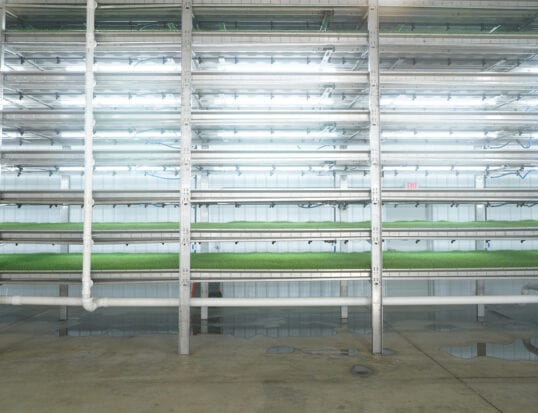Automated Vertical Pastures™ are a leap forward for HydroGreen Global Systems, a division of CubicFarm Systems Corp., that could spark a green revolution in feeding cattle on medium and large-scale livestock farms around the world.
It’s a new livestock feeding solution in a new industry category called local chain farming, which encompasses automated indoor machine technology that empowers farmers to localize plant, food, and livestock feed production at a commercial scale while protecting people, resources, and the economy.
“A HydroGreen’s Automated Vertical Pasture™ is a sustainable technology solution for farmers to reduce risk and unpredictability,” says Dan Schmidt, President of HydroGreen. “What dairy nutritionists and farmers are looking for is consistency—and this system provides live, high-quality fresh animal feed on the farm every day,” he says, adding that the type of feed can be altered, depending on whether the animals are pre-calving, calving, milking, or dry.
Drought and access to water
In North America, Schmidt says there are about 10 million milking cows and about two per cent of the largest producers account for two-thirds of the milk production. Proper nutrition is essential to maximize milk production and moderate to extreme drought is impacting the availability of enough healthy, nutritious livestock feed for their herds.
Enter the HydroGreen technology, which is a fully automated hydroponic indoor growing system that sustainably and consistently produces highly nutritious and digestible livestock feed. With the push of a button, one person can produce an entire crop of on-farm fresh forage —usually wheat or barley—from seed to feed in six days. That includes all the seeding, watering, lighting, and harvesting. The growing surfaces are vertically stacked on conveyor belts and can be six or eight levels high.
“In our pilot project with our Farmer Partner, Burnett’s Land & Livestock Ltd., the system will generate 8 tons of dry matter feed a day,” Schmidt says. Burnett’s is located in Wyoming, owns 30,000 acres of land, and has a total of about 17,000 animals—6,000 milking cows, 5,000 calves and heifers, and 6,000 beef cattle.
Until recently, HydroGreen Automated Vertical Pastures™ have been sold to smaller operations with 100 to 250 head herds. Building on this highly successful technology, the next-generation Automated Vertical Pastures™ solution currently being installed and tested at Burnett’s will be able to feed about 2,000 animals in the initial stage.
“The plan for Burnett’s is to start with 12 machines, while building the infrastructure to be able to handle another 24 and then potentially 48 machines,” he says.
While HydroGreen Automated Vertical Pastures™ will begin with dairy cattle, the plan is to expand into beef and other livestock species in the future. With increasing global demand, HydroGreen Automated Vertical Pastures™ will also be sold around the world.
Schmidt says that another big issue for commercial-scale farmers is that state regulations and policies around water—especially in the US Midwest—are tightening as access to it becomes tougher.
“In Colorado, you can’t drill or move a well, or even collect rainwater,” he says, adding that Automated Vertical Pastures™ will be a reliable solution to feeding thousands of cattle without needing or using thousands of acres of land.
“HydroGreen Automated Vertical Pastures™ uses 95% less water than traditional central pivot irrigation systems that farmers typically use,” Schmidt says, cautioning that this figure depends on the location of the farm and the kinds of climatic conditions in which the farm operates.
A comprehensive solution
HydroGreen Automated Vertical Pastures™ are more than just growing machines—they’re an entire feed solution, according to Schmidt. This includes a seed cleaner, water delivery, automated conveyors, and shredders for harvesting. Post-harvest, the fodder goes into a feed mill or feed mixer. There is also an HVAC system that controls temperature and humidity to maintain an optimal environment for the plants.
Schmidt says that, while consistency is the number one concern for farm business owners, a close second is dealing with the vagaries of nature, including drought, pests, weeds, disease, hail, and snowstorms. As a result of it being a modular, indoor technology that’s located right on the farm, HydroGreen Automated Vertical Pastures™ take care of both.
Nearly every farm has slightly different needs, depending on how they operate, and HydroGreen Automated Vertical Pastures™ have the flexibility to accommodate those demands.
Growing the farm to make it sustainable
Schmidt points out that expanding production is a bigger and bigger issue across the U.S. In the Burnett’s case, they want to produce more milk, but can’t really buy more land at their location and they’re restricted in their access to water.
“Their intention is to get to 48 machines in the next two years, and eventually double that in the future,” he says, adding that the first 48 machines will allow the family to increase their milking herd from 6,000 to 8,000 to 8,500 heads with the same amount of land and the same square footage in the building.
The pilot project at Burnett’s is under way, with shovels in the ground and a plan to install the system and start producing feed in the fourth quarter of 2021.
